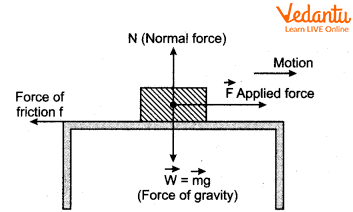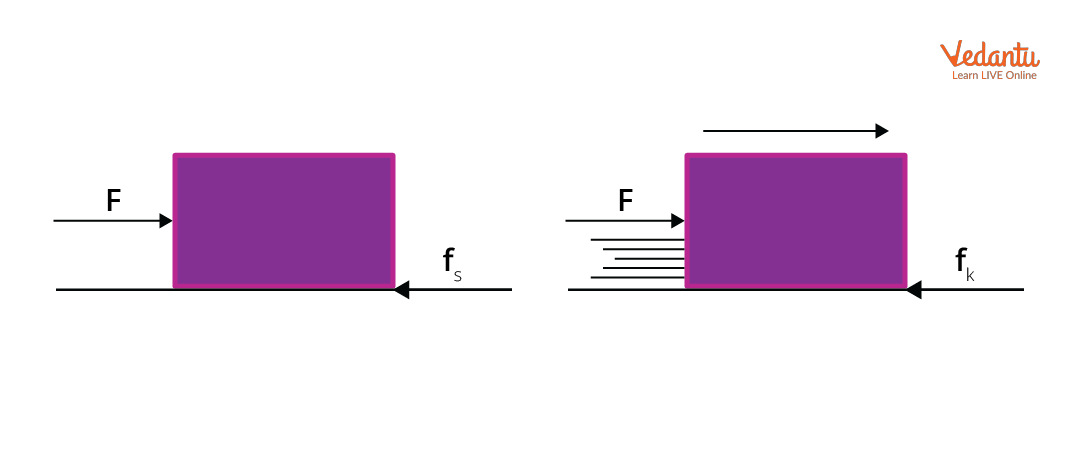




What Are the Different Types of Friction and How Do They Affect Movement?
Friction is a mechanical force that arises when two surfaces are in contact and resist each other's relative motion. It is a fundamental concept in physics, playing a key role in daily phenomena as well as in advanced engineering applications.
Friction: Basic Definition and Characteristics
Friction is defined as a contact force that opposes the relative motion or tendency of such motion between two surfaces in contact. The direction of the frictional force is always parallel to the surface of contact and opposite to the direction of intended or actual motion.
Frictional force acts due to the microscopic irregularities present on the contacting surfaces and the intermolecular forces at the interface. Its magnitude depends on the nature of the surfaces and the normal force acting between them. For JEE-level problems, friction is always considered as a tangential force at the point of contact.
Origin and Nature of Friction
Friction originates from the roughness of surfaces at the microscopic level and the interlocking of microscopic projections. Even seemingly smooth surfaces have irregularities that cause resistance to motion. The force is enhanced by the adhesion between molecules of the surfaces in contact.
The actual area of contact at the microscopic level is much less than the apparent area. The local deformations and embracing of projections raise the opposition to motion, leading to frictional forces that depend on the materials and surface properties.
Types of Friction
Friction can be classified into several types, primarily based on the state of relative motion between the surfaces. The major types include static friction, kinetic (dynamic) friction, sliding friction, and rolling friction. Further explanation on these types is provided in the Types Of Friction resource.
Static friction acts when no relative motion exists between the bodies, preventing the initiation of sliding. Kinetic friction comes into play once motion has started. Kinetic friction can be subdivided into sliding friction when surfaces slide and rolling friction when one body rolls over the other.
Static Friction
Static friction is the force that resists the initiation of motion between two objects. It adjusts its magnitude up to a maximum value, after which motion commences. This maximum value is called the limiting friction.
The law of limiting friction states that, at the verge of motion, the maximum static friction $f_s$ is proportional to the normal reaction $N$:
$f_s = \mu_s N$
where $\mu_s$ is the coefficient of static friction, determined by the nature of the surfaces.
Kinetic Friction
Kinetic friction acts between surfaces in relative motion. Its value usually remains nearly constant and is denoted as $f_k$:
$f_k = \mu_k N$
Here, $\mu_k$ is the coefficient of kinetic friction. Experimentally, $\mu_k < \mu_s$, indicating that less force is required to maintain motion than to initiate it.

Sliding and Rolling Friction
Sliding friction occurs when two solid surfaces slide over each other, while rolling friction occurs when one body rolls on another. Rolling friction is significantly smaller than sliding friction. This reduction is why ball bearings and wheels are widely used in machinery and vehicles.
The magnitude of rolling friction depends on factors such as deformation of surfaces and properties of the materials in contact.
Laws of Friction
The empirical laws of friction are summarized as follows. First, the frictional force is independent of the area of contact, provided the normal reaction is constant. Second, the force of friction is directly proportional to the normal force, as represented by $f = \mu N$. Third, the value of friction depends entirely on the nature and state of the surfaces in contact.
The coefficients of friction are determined experimentally for different surface pairs. For a detailed discussion, refer to the Laws Of Static, Kinetic, And Limiting Frictions page.

| Type of Friction | Coefficient Range |
|---|---|
| Static Friction ($\mu_s$) | Generally 0.2 – 0.7 |
| Kinetic Friction ($\mu_k$) | Generally 0.1 – 0.6 |
| Rolling Friction ($\mu_r$) | Generally 0.01 – 0.02 |
Factors Affecting Friction
The main factors influencing friction include the surface roughness, normal force, and material properties. Friction does not depend significantly on the apparent area of contact. Increase in surface roughness or normal force increases friction between surfaces.
- Surface texture and roughness
- Normal reaction force applied
- Material and condition of surfaces
Consequences of Friction
Friction produces heat when objects move against each other. This dissipated energy can be useful or cause unwanted effects such as wear and tear in machinery, leading to material loss and reduced efficiency.
Applications such as walking, writing, and braking in vehicles depend on friction. However, excessive friction leads to energy losses that must often be minimized in engineering systems.
Reduction and Control of Friction
Friction can be reduced by polishing contact surfaces, applying lubricants, or using rollers and ball bearings. Lubricants form a thin film that separates the contacting surfaces, reducing the direct contact and thus the frictional force.
In many mechanical assemblies, applying coatings or introducing soft materials between metal surfaces lowers the coefficient of friction and aids in smoother operation.
Friction Force Formula and Numerical Calculation
For most engineering and physics applications, the frictional force is calculated using $f = \mu N$, where $f$ is the frictional force, $\mu$ is the coefficient of friction, and $N$ is the normal force. Analytical understanding of this relation is crucial for solving various mechanics problems.
A deeper perspective on the friction force formula and related solved examples can be explored in the Friction Practice Paper resource.
Comparison of Static and Dynamic (Kinetic) Friction
Static friction is variable up to its maximum (limiting) value and prevents motion, while kinetic (dynamic) friction remains nearly constant once motion starts and is always less than the maximum static friction.
The difference between static and dynamic friction is vital in understanding how objects start and continue to move. Further detail is available at the Difference Between Static And Dynamic Friction page.
Friction Versus Viscosity
While friction primarily involves solid surfaces, viscosity is the analogous resistance for fluids, describing the internal friction of moving fluid layers. For a precise distinction, refer to Difference Between Friction And Viscosity.
Typical Applications and Importance in Physics
Friction is fundamental to daily processes and technologies, providing the resistance necessary for movement but also presenting challenges such as heat generation and material degradation.
- Walking and gripping rely on static friction
- Brakes and clutches use kinetic friction
- Bearings utilize minimized rolling friction
To reinforce understanding and improve problem-solving skills in friction, students may review key problems using the Friction Important Questions resource.
FAQs on Understanding Friction: Basics, Types, and Examples
1. What is friction?
Friction is a force that opposes the relative motion between two surfaces in contact.
Key points about friction:
- Acts parallel to surfaces that are touching
- The direction is always opposite to the motion
- Caused by microscopic irregularities between surfaces
2. What are the types of friction?
There are four main types of friction, each acting under different conditions.
These include:
- Static friction: Prevents surfaces from sliding past each other
- Sliding (Kinetic) friction: Occurs when two surfaces are moving over each other
- Rolling friction: Acts when an object rolls over a surface
- Fluid friction: Acts on objects moving through fluids (liquids or gases)
3. What are the factors affecting friction?
The main factors affecting friction are:
- The nature of the surfaces in contact (smooth or rough)
- The force pressing the two surfaces together
4. Why is friction sometimes considered a necessary evil?
Friction is called a 'necessary evil' because it has both advantages and disadvantages.
For example:
- Helps us walk without slipping
- Essential for writing, holding objects, and driving vehicles
- Causes wear and tear, produces unwanted heat, and wastage of energy
5. How can friction be increased and decreased?
Friction can be increased or decreased based on need.
To increase friction:
- Make surfaces rougher
- Add sand or grip to shoes
- Use treads on tires
- Apply lubricants (oils, grease)
- Use ball bearings
- Polish surfaces
6. What are the disadvantages of friction?
Major disadvantages of friction include:
- Produces unwanted heat leading to energy losses
- Causes wear and tear of machinery, tools, and shoes
- Needs extra force or fuel to overcome friction in engines
7. How does lubrication reduce friction?
Lubrication reduces friction by creating a thin layer between moving surfaces.
This layer:
- Minimizes direct contact between surfaces
- Reduces wear and heat buildup
- Makes movement smoother and more efficient
8. Give some examples where friction is useful in daily life.
Friction plays a crucial role in daily life.
Some useful examples:
- Walking or running without slipping
- Writing with a pen or pencil
- Brakes stopping a bicycle or car
- Holding and gripping objects
9. What is static friction?
Static friction is the force that prevents an object from starting to move when a force is applied.
Key facts:
- Acts when there is no relative motion between surfaces
- Always equal and opposite to the applied force, until it is overcome
- Maximum just before motion starts, also known as limiting friction
10. What is fluid friction? Give one example.
Fluid friction is the force that opposes the movement of an object through a fluid (liquid or gas).
Example:
- When a swimmer moves through water and feels resistance
























